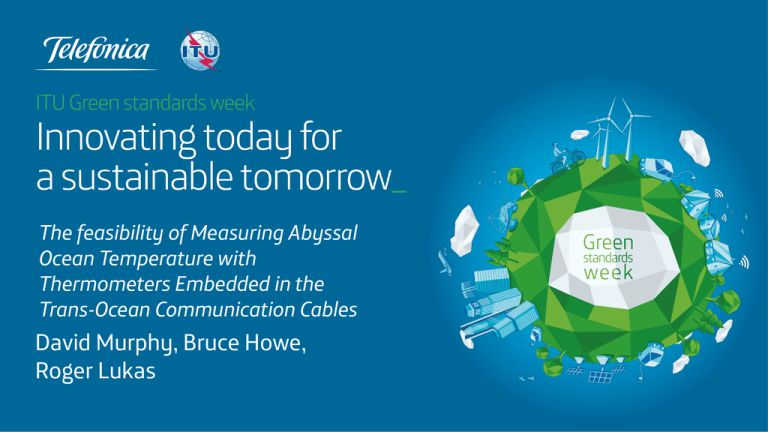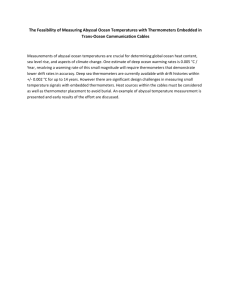The feasibility of Measuring Abyssal Ocean Temperature with Thermometers Embedded in the
advertisement

The feasibility of Measuring Abyssal Ocean Temperature with Thermometers Embedded in the Trans-Ocean Communication Cables David Murphy, Bruce Howe, Roger Lukas The Feasibility of Measuring Abyssal Ocean Temperatures with Thermometers Embedded in Trans-Ocean Communication Cables David 1 Murphy , Bruce 2 Howe , 1) Sea-Bird Electronics 2) School of Ocean and Earth Science and Technology University of Hawai’i at Manoa Roger 2 Lukas Points of Discussion • We are interested in two things – Accurately measuring ocean temperature at the seafloor – Accurately estimating the rate of warming or cooling of the deep ocean • What accuracy and measurement drift performance do we need? – Are we able to meet these requirements? (yes) • A seafloor data example to consider What Are We Interested in Measuring? • Will discuss an example from: Purkey, S., G. Johnson, 2010: “Warming of Global Abyssal and Deep Southern Ocean Waters between the 1990s and 2000s: Contributions to Global Heat and Sea Level Rise Budgets” Journal of Climate, Vol 23, pp 6336 – 6351. – Published by the American Meteorological Society Data Source • Instrumentation lowered from ships along tracks shown on the right • Measurements repeated through 1990s and 2000s, continue to present • Data collected by international science programs: WOCE, CLIVAR, et. al. Observed Warming Rates in Southern Ocean • Grey shading indicates ocean floor • As in all models of climate change, some places get warmer, some colder • Note very high spatial variability, instrumented cable address this • Note scale at the bottom, +/0.1°C/decade • Will focus on area with green asterisk Observed Warming Rate Near Ocean Floor at 4000 Meters Depth • Estimated warming rate 0.1°C/20 years • 0.005 °C/ year • Dotted lines are 95% confidence level, estimated from spatial variance – not temporal variance • Instrumenting cables will address this shortcoming by providing a time series of measurements in many locations Suitable Deep Sea Thermometer • Bottom plot is drift history of candidate thermometer – Shows the stability of the thermometer in the field 0,0104 Temperature (Deg.C.) – Shows the stability of the calibration 0,0105 0,0103 0.001 (C) Full Scale 0,0102 0,0101 0,0100 0,0099 0,0098 0,0097 0,0096 0,0095 1994 1997 1999 2002 2005 2008 2010 SBE 38 Drift (C) 0,010 0,008 0,006 Residual Error (C) • Top plot is calibration standard used for deep ocean temperatures Primary Std at Triple Point of Water 0,004 0,002 0,000 -0,002 -0,004 -0,006 -0,008 -0,010 0 2 4 6 8 Years After Manufacture 10 12 14 Problems We Face • Cable repeaters dissipate power (heat) continuously into the seawater environment – 56 Watts maximum – 25 – 30 Watts typical • Power wire in cable dissipates power (heat) continuously – 1 Amp DC constant supply current – Power line resistance depends on wire type and temperature, at 3 degrees C • 0.95 Ohm/km for SL17 • 0.72 Ohm/km for SL21 – Worst case I2R power is 950 µW/m • Thermistor in Sea-Bird products typically has self heating of ~ 3 µW • Cables use seawater ground – No contribution to heat budget Example: ALOHA Cabled Observatory • Seafloor deployment of multi-parameter ocean observing system • Power and data from repurposed communication cable • System includes measurement of abyssal temperature What it looks like on the Seafloor Mosaic of Seafloor Installation Position of Power Supply and Thermometer • CTD swings out of frame, up and over upon deployment power supply Note CTD in undeployed mode – upside down, opposite side Seafloor Temperature Record – Spikes from heat of power supply 0.01°C raw temperature (red) with spikes and de-spiked (blue) 0.001°C Data Is Useful But Requires Manipulation • Data is de-spiked and averaged daily • Variations are real and not equipment induced artifact HOT CTD • • • Red crosses are data from equipment lowered from ship ~ 1.2 km distant Ship’s instruments measure for a few minutes at depth each monthly visit Continuous sampling yields much more information than intermittent data from ships 20 m°C 4 m°C HOT CTD Design Challenges • Embedding a thermometer in or very near a repeater will not yield useful data • Embedding a thermometer in a cable at some distance from a repeater much more attractive – Must design to shield thermometer from heating within the cable from power wire – Need to model heat flow within the cable – Best design would have multiple thermometers at each repeater to avoid being buried in the mud • Candidate designs should be tested in-situ at a site such as the ALOHA Cabled Observatory Courtesy Peter Phibbs and TE Subcom Thank you




